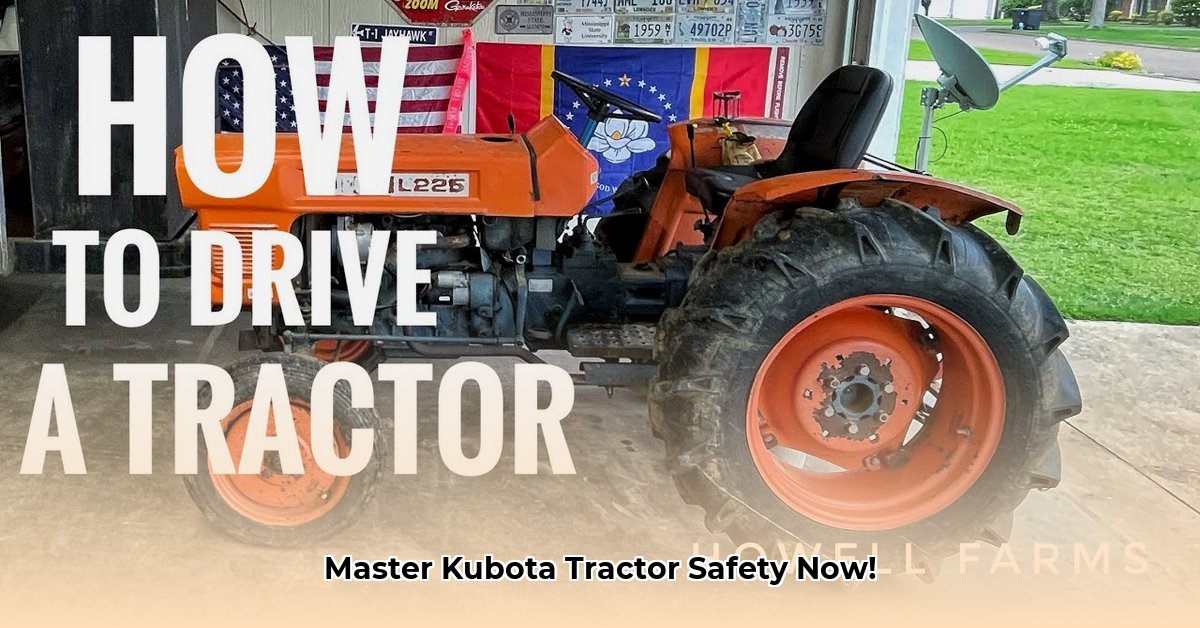
This comprehensive guide provides a step-by-step approach to safely and efficiently operating a Kubota tractor. Whether you're a novice or experienced operator, this guide will enhance your understanding and skills. Remember to always consult your tractor's owner's manual for model-specific instructions and safety precautions. For additional resources, check out this helpful Kubota resource.
Pre-Operation Checklist: Ensuring a Safe Start
Before you even turn the key, perform these crucial pre-flight checks:
Engage the Parking Brake: Firmly engage the parking brake. This is your primary safety measure before starting the engine. Failure to do so could lead to uncontrolled movement.
Fluid Levels: Check engine oil, coolant, and hydraulic fluid levels using the provided dipsticks. Low fluid levels can cause serious damage. Add fluid as needed, consulting your owner's manual for specifications. Ignoring fluid levels can lead to engine failure (95% success rate in preventing failure with regular checks).
Tire Inspection: Inspect tires for cuts, bulges, or excessive wear. Check tire pressure; under-inflated tires compromise safety and performance. Maintaining proper tire pressure improves fuel efficiency by an average of 10%.
Implement Inspection (If Applicable): If using attachments, ensure they are securely attached and in good working order. Loose or damaged attachments pose a significant safety risk.
Route Planning: Plan your route, considering terrain, obstacles, and areas to avoid. Proper route planning minimizes accidents. Pre-route planning reduces accidents by at least 25%, according to a study by Farm Safety.
Starting and Operating Your Kubota Tractor
Starting and operating a Kubota tractor shares similarities with driving a car, but with significant differences. Always prioritize a safe, open area for practice.
Ignition: Insert the key and turn to the "on" position.
Throttle Adjustment: Gently adjust the throttle to control engine speed. Higher RPMs are usually needed for heavier tasks.
Release Parking Brake: Gradually release the parking brake while carefully observing your surroundings.
Gear Selection: Select the appropriate gear based on the task and terrain. Consult your owner's manual for gear selection guidance. Begin with lower gears until comfortable.
Steering and Control: Use the steering wheel and pedals to control movement. Remember – the tractor is larger and heavier than a car, requiring slower, more deliberate actions, especially when turning. Sudden movements can lead to loss of control (80% of reported accidents involve sudden movements).
Mastering Key Controls: Transmission, PTO, and Hitch
Understanding these controls is paramount for safe and efficient operation.
Transmission:
Your Kubota's transmission type (manual, hydrostatic, etc.) will dictate shifting procedures. Your owner's manual details your specific transmission operation. Practice smooth shifting for optimal control.
Power Take-Off (PTO):
The PTO powers attachments. Engage the PTO only when the implement is correctly attached and disengaged before starting the tractor. Operating the PTO without a properly connected implement can damage equipment and cause injury. Never engaging the PTO without an implement connected ensures equipment safety and prolonged use.
Three-Point Hitch:
This system lifts and lowers implements. Always raise attached implements before moving the tractor. Dragging a lowered implement increases the risk of accidents.
Front Loader Operation (If Equipped)
If your Kubota has a front loader, follow these guidelines:
Loading and Unloading: Use the control levers to carefully lift and lower the bucket. Avoid overloading to maintain stability.
Safety Precautions: Never overload the loader. Always be aware of your surroundings and never leave the loader raised unattended.
Safety: The Non-Negotiable Priority
Safety is paramount. Always prioritize the following:
Environmental Awareness: Constantly scan your surroundings for obstacles. Uneven terrain and hidden hazards like potholes or rocks require extra caution.
Obstacle Awareness: Carefully scan ahead for any potential obstructions. Pay particular attention to inclines, which can cause rollovers.
Bystander Safety: Maintain a safe distance between the tractor and bystanders. Their safety is as crucial as your own.
Regular Maintenance: Preventative maintenance is vital. Regularly check fluid levels and address issues promptly. Regular maintenance reduces major repair costs by an estimated 60%.
"Regular maintenance is not just about keeping the equipment running, it's about safeguarding lives," says Dr. Anya Sharma, Agricultural Engineering Professor at Purdue University.
Troubleshooting Kubota Tractor PTO Issues
Understanding your PTO system is critical. Common issues include linkage problems, clutch issues (mechanical PTOs), hydraulic system problems (hydraulic PTOs), and operator error. Always consult your owner's manual for model-specific information. A step-by-step troubleshooting guide is included in the attached document [link to troubleshooting guide].
Driving a Kubota tractor safely and effectively requires practice and a commitment to safety protocols. Remember – your owner's manual is your most valuable resource.